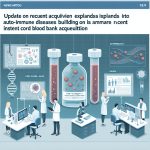YD Bio Limited has completed its business combination with Breeze Holdings Acquisition Corp. and will begin trading on the Nasdaq Global Market on August 29, 2025, under the ticker symbols YDES and YDESW. The deal delivered more than $11.5 million in gross proceeds from a PIPE and remaining SPAC trust cash to fund operations. The newly public company positions itself across DNA methylation-based oncology diagnostics, exosome and stem cell ophthalmology programs, and a clinical trial supply business.
The strategic question is whether a diagnostics-regenerative hybrid with modest fresh capital can translate public-market visibility into clinical and commercial momentum fast enough. The cash runway implied by $11.5 million is short in today’s development environment, suggesting near-term dependence on partnerships, disciplined milestone setting, and non-dilutive funding to move multiple programs in parallel. For senior commercial and medical leaders, this is less a financing event than an execution test in crowded, fast-evolving markets.
The immediate commercial hinge is oncology diagnostics. YD Bio’s DNA methylation portfolio includes a blood-based pancreatic cancer screening test, already offered as a laboratory-developed test through a partner’s CLIA lab, and a breast cancer recurrence monitoring LDT, expected to be launched later this year. This timing coincides with the industry’s LDT inflection point, as the FDA phases out broad enforcement discretion, shifting diagnostics toward IVD pathways over the next several years. The window for pure LDT commercialization is narrowing, and payers are shifting their focus from analytic validity to clinical utility and outcomes before granting coverage. For patients and HCPs, the relevance is clear—earlier detection and better surveillance change trajectories—but payer acceptance will hinge on prospective evidence, event reduction, and cost offsets, not just sensitivity and specificity.
Competition is unforgiving. In early detection and recurrence monitoring, established players like Grail, Guardant, Exact Sciences, Natera, and Delfi are setting the evidence bar and shaping payer policy. A pancreatic-first strategy could carve a niche if the test demonstrates superior performance in high-risk cohorts or targeted clinical pathways, but general population screening lacks guideline support. In breast cancer recurrence, MRD-oriented assays already enjoy growing clinical adoption; without head-to-head comparisons or robust real-world effectiveness, share capture will be uphill.
The ophthalmology pipeline—encompassing exosome-based contact lenses and artificial tears, as well as corneal stem cell approaches—opens an orthogonal growth avenue, albeit with longer timelines and increased regulatory complexity. Exosomes remain a manufacturing, characterization, and regulatory challenge that likely involves combination-product considerations and CMC scrutiny. With clinical work anticipated to begin in 2027, these programs will require sustained capital and credible translational data packages to attract partners and payer interest in diseases like dry eye, glaucoma, and corneal injury.
One underappreciated lever is YD Bio’s clinical trial and ancillary supply business, which can generate cash flow and establish relationships with global pharmaceutical companies. If integrated smartly, it could become a channel for evidence generation, co-development, and regional licensing—particularly valuable as diagnostics shift toward outcomes-based contracts and employer-led pilots.
In a market where SPACs are trickling back and diagnostics face higher evidentiary and regulatory bars, YD Bio’s public debut matters less for its listing mechanics and more for what it funds next. The near-term watch list for competitors, payers, and potential partners is straightforward: prospective data for the pancreatic screen in defined-risk populations, launch traction for the breast recurrence LDT with early utility signals, clarity on an FDA engagement plan for post-LDT transition, and a credible financing and BD cadence. Can the company convert a small-cap listing into data-rich milestones within 12–18 months that bend payer and HCP behavior, or will it be forced to narrow focus and out-license to survive?
Jon Napitupulu is Director of Media Relations at The Clinical Trial Vanguard. Jon, a computer data scientist, focuses on the latest clinical trial industry news and trends.







